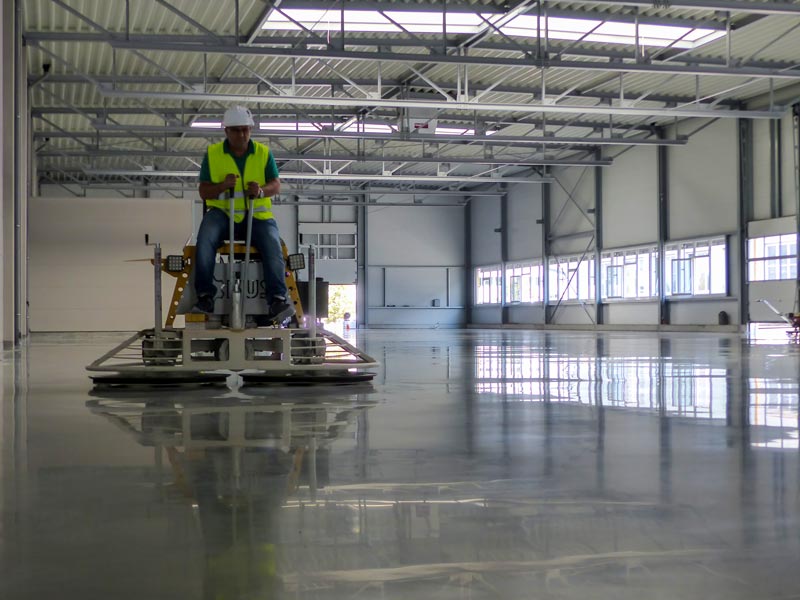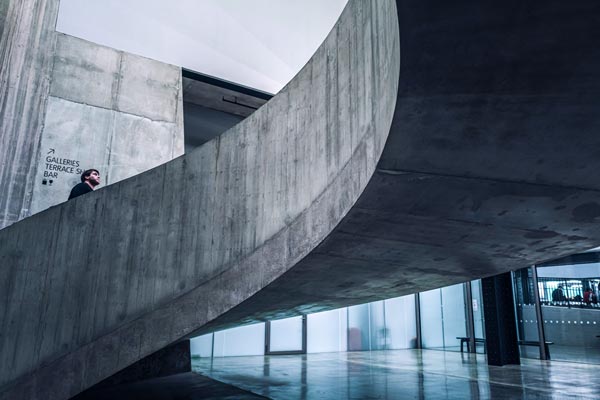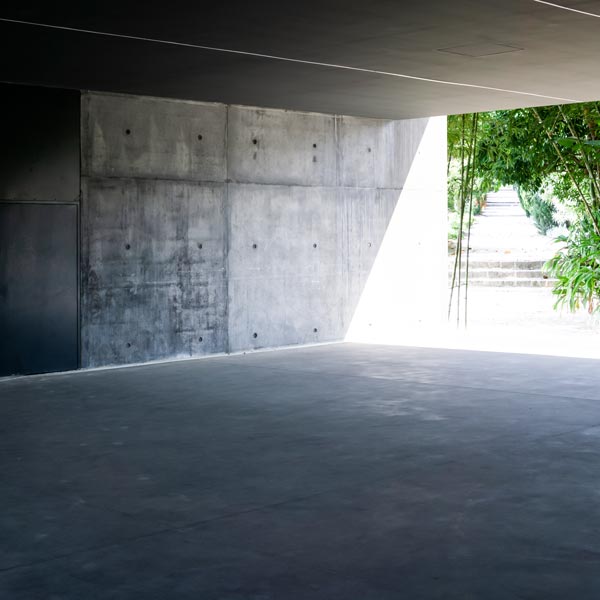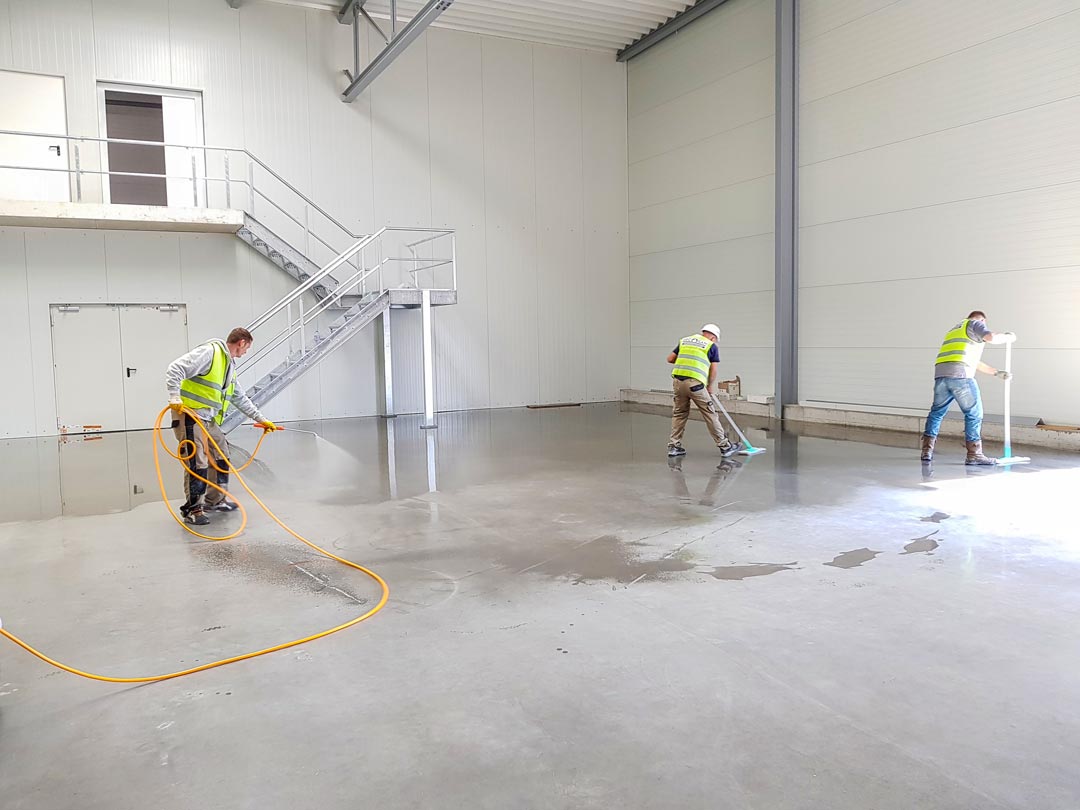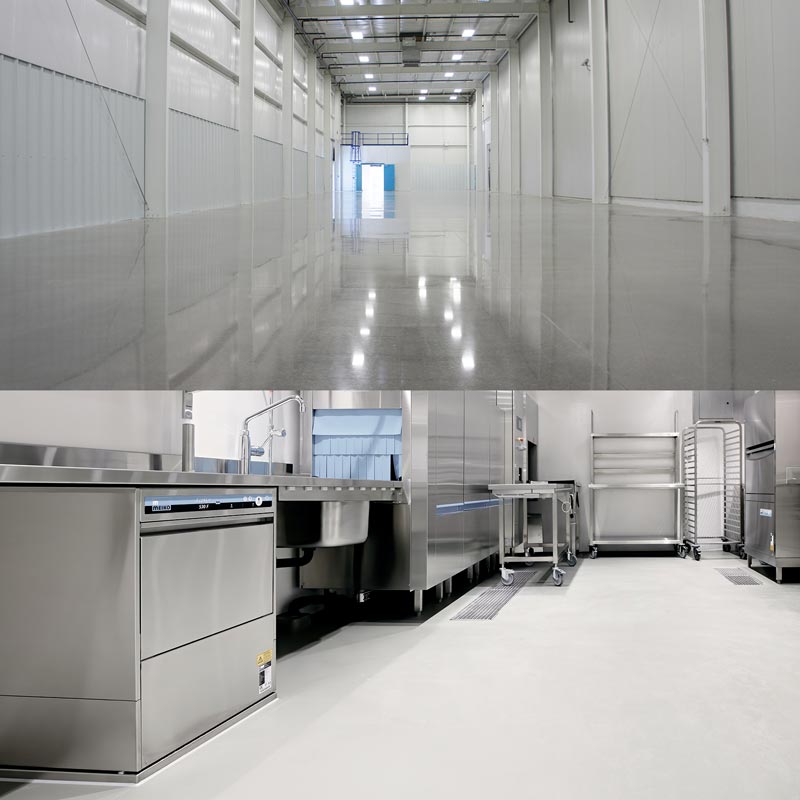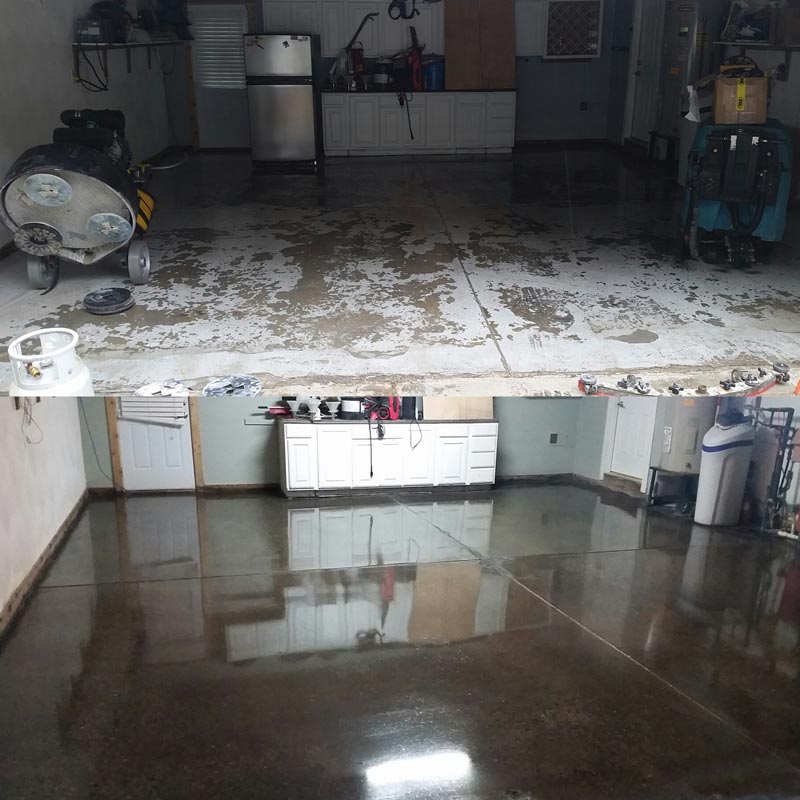
Quite a few times, we hear polished concrete and sealed concrete used as synonyms. While they might sound similar, the similarities between polished concrete vs sealed concrete end there. Can you tell from the picture above, which floor is polished and which one is just sealed? The process that gets us to calling concrete “finished” between these two-word combinations is like day and night.
Let’s get started with going over what sealed concrete is. You’ll quickly understand how different they are if you have read any of our posts about polished concrete floors. If you haven’t, you can read them by clicking here: polished concrete floor posts.
What is sealed concrete?
What we call by the term “sealed concrete” is a bare concrete floor that has been sealed with a unique acrylic sealer. Yup, that’s pretty much it. Once the concrete floor is completely dried out after leveling it, it gets cleaned, and then the sealer is applied.
Sealed Concrete Installation
The installation process goes something like this: the concrete is cleaned and allowed to dry. A layer of acrylic sealer is similarly spread on the concrete as paint would.
This type of sealer fills in the gaps and dips with a plastic-like filling, which creates a shiny surface once dry. While polished concrete floors look shiny due to mechanically grinding it out of them… Literally.
A cheap low traffic flooring solution
While some sealed concrete floors are primarily designed to prevent moisture from penetrating under the finished floor, sealed concrete is being used as a cheap floor finish in low-traffic areas. Sealed floors do not look great, and you will not be able to see a clear mirror-like reflection in them as you would with polished concrete floors that were finished right.
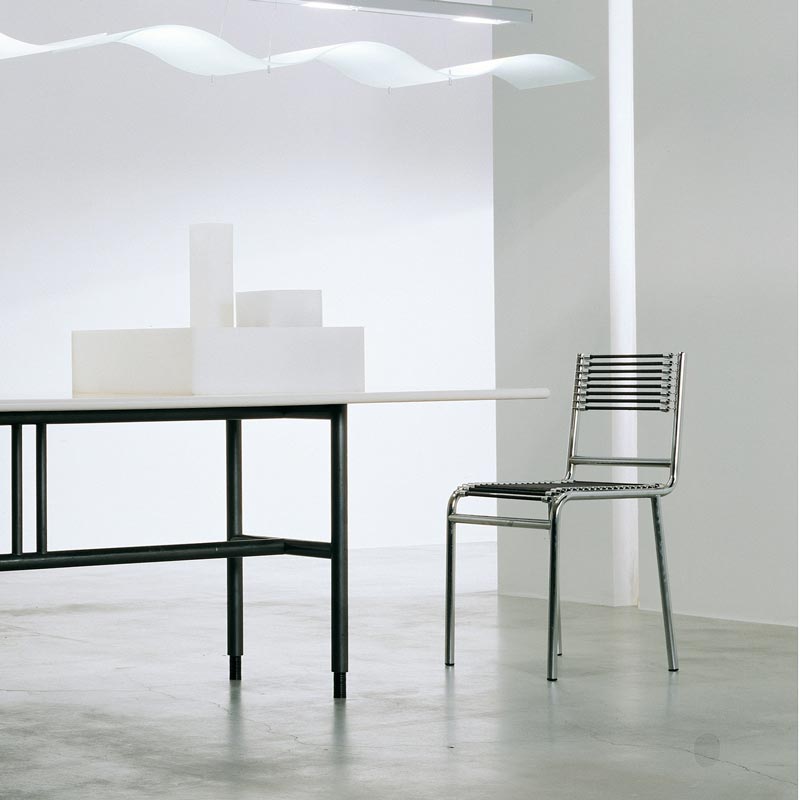
Besides not being the most attractive floors to look at, sealed floors tend to wear down quickly and are sensitive to moisture. The more they wear down, the more prone they will get to liquid absorption. The more staining occurs on sealed concrete floors, the worse they will look.
Mechanical damage to the floors due to heavier traffic is also one reason why sealed concrete floors are not a great choice. Walking over these floors will start chipping away at the sealer on its own until you will need to lay another layer of sealer to preserve the concrete underneath. As you can imagine, due to uneven wear patterns, it is a matter of time when these types of floors become an eyesore.
Labor intensive upkeep
While polished concrete floors are generally a pretty low maintenance flooring solution, sealed concrete requires quite intense work in shorter periods. It will cost much less initially; however, the costs will start adding up quickly with each rewaxing of the floors.
Sealed concrete can be used on walls or areas with low traffic. In any other case, they will not be cost-effective and will end up at a higher price point than polished concrete floors in the long run. Besides, acrylic sealers are not suitable for the environment.
What is polished concrete?
There is a clear winner when it comes down to the battle between polished concrete vs sealed concrete floors. Yup, you guessed it, polished concrete trumps over sealed concrete in any way you look at it.

How polished concrete floors are done
Let’s go over why polished concrete floors are a better choice than sealed concrete floors. For starters, the first step of getting excellent, shiny, mirror-like finish floors, we use fine grit diamond tools to shave the tiny portion of the top layer of concrete. This process levels the concrete surface and eliminates scratches. If you touch the floors, you will instantly feel how smooth they are after completing the polishing steps.
While lower grit tools are used to shave off a tiny layer off the concrete, higher grit tools are used to close off the concrete’s pores. One crucial step is not to forget that happens anywhere between 80 grit and 400 grit grinding, depending on how hard or soft the floor is.
Densifying concrete floors
It is essential to densify or what some concrete polishing contractors call, to “feed” the concrete with a densifier. Densifier does not only give the concrete a much deeper, richer color. It also makes the floors more durable and stain-resistant.
Densifiers consist of penetrating lithium silicate that reacts with concrete. This reaction then produces insoluble calcium silicate hydrate inside the pores of the concrete. In return, this increases the hardness of the concrete itself and increases the floors’ longevity while reducing dusting and staining.
Even though a densifier is applied on top of the concrete, it doesn’t sit there for long. Concrete will absorb the densifier, and you might even see it dry fast right before your eyes. It is essential to not over-apply densifier since over-application will result in dust clouds on the following steps and can ruin the finished product.
Filling in gaps and holes
During the grinding stages, all cracks should be filled in and repaired to get the floors to an even and smooth surface. Filling in holes and gaps is very important for many reasons that we will not be getting into in this article. You can check out a post about concrete floor repair here.
Polished concrete floor texture differences
Depending on concrete’s aggregate composition, many different types of textures come up to the surface during the polishing process, making your floors beautiful and unique. No concrete slab will look the same unless there is a very thick layer of concrete “cream” on top, a troweled cement paste.
Under this “cream” layer, the “salt and pepper” layer is the aggregate made out of the finest sand and tinniest stones. To get your floors to this look, more of the cream would have to get removed from the top.
After the “salt and pepper” layer, we have the “exposed aggregate” layer, which is similar to the “salt and pepper” layer but with larger particles of sand and stones. This layer can be reached by grinding through the salt and pepper layer. However, it is not as customizable and even as the “cream” layer of polished concrete floors.
Accomplishing wanted gloss levels
A common term “gloss” refers to the reading of how shiny the floor is. This reading can be acquired by using a gloss meter on the finished concrete floor. There are a lot of variables that affect how shiny your finished floors will be.
Let’s quickly go over what you should not be doing during the whole concrete grinding and polishing process since they will affect the finished product. Often, if you start cutting corners somewhere in the process, you will not be able to realize how these “corners” will pop until the end. The shinier the floor will get, the better you will see the imperfections left by not following the proper procedures.
For a more in-depth look at the responsibilities of concrete polishing companies visit this article.
Things not to do when polishing concrete floors

One of the main things to keep in mind when working on concrete floors is that less is more. We do not mean that you should do less work on the floors; however, we suggest to do each step at a slower pace. If you are cutting the floors, it is imperative to move the grinder slowly and even rate.
Uneven grinder movement can cause a “wavy look” on the floors that will only be seen in later steps. To minimize this type of wavy effect, we would recommend cross-cutting your lines.
Another thing not to do is not to skip steps. We had the pleasure of working on a few of our customers’ floors that were firstly done by a contractor that was mixing densifier with water to save on their project costs. We have also enjoyed working on floors that had steps skipped during the grinding and polishing process.
What might seem like a time-saver, in the beginning will come to bite you in the behind at the end of the project. Skipping steps in grinding and/or polishing will cause the floor not to look as shiny as it possibly could have looked.
We have seen happening is technicians not using high-speed burnishers to heat the concrete sealer at the very end. We usually use a 3000 grit pad on a high-speed burnisher and slowly burnish the whole area that we worked on that day.
Things to do to get the best gloss levels

One of the biggest separators between polished concrete vs sealed concrete floors is the gloss levels that you can accomplish with polished concrete. So how do you get the best gloss possible?
The “Things not to do when polishing concrete” above covers the few biggest things that will prevent your floors from having the best shine. So if you want to accomplish the best gloss, you will do just the opposite.
Go over each of the steps slowly. The slower the grit that you are using, the slower your grinder should be moving.
Do not skip the densifying step. If you skip this step, you will not only leave your concrete floors less durable, but you will lose some gloss points as well.
Dot not over-densify. If you put too much densifier on your floors, you will not only cause clouds of dust on your following steps, but you will also have a dirty or even cloudy looking floor.
Wash the floors properly between each step. You do not want to have dirt lying on the floors when you spread a densifier or sealer with your microfiber pad. If you seal dirt into your floors, you will have to grind the sealer off and repeat the process for that area to call it “fixed.”
Use quality sealer at the end, wait for it to dry entirely, and burnish it with a high-speed burnisher. This is the “cherry on top” step that will get your floors looking as shiny as they possibly can.
Polished Concrete vs Sealed Concrete: Conclusion
As you can tell, polished concrete floors will be much more durable and require less maintenance than sealed concrete floors. This is caused by the work that the technicians put into these floors during the grinding and polishing process.
Shaving off the floors’ imperfections to closing off the concrete pores, and “feeding” the floor with densifier are crucial steps to take to increase the floors’ longevity. Some polished concrete floors are known to last for 20 years if maintained well. We can’t say the same about sealed concrete floors.
Sealed concrete floors are a cheap flooring solution. These types of floors are usually done in shallow traffic areas just for minimal protection. Meanwhile, concrete floors can handle much more traffic on them, are one of the most popular flooring solutions nowadays, look great, etc. There are tons of benefits to having polished concrete vs sealed concrete.
If you are still not convinced about polished concrete floors, you could also look into epoxy concrete floors. They are more expensive but can fit better than polished concrete in very high traffic or heavy-duty machinery traffic environment. They are also used widely in areas where chemical spills have a possibility of happening. Here is our article on Epoxy Floors vs Polished Concrete Floors.
